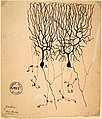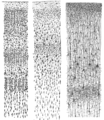Santiago Ramón y Cajal
Santiago Ramón y Cajal | |
|---|---|
 Santiago Ramón y Cajal vào năm 1899 | |
| Sinh | (1852-05-01)1 tháng 5 năm 1852 Petilla de Aragón, Navarre, Tây Ban Nha |
| Mất | 18 tháng 10 năm 1934(1934-10-18) (82 tuổi) Madrid, Tây Ban Nha |
| Quốc tịch | Tây Ban Nha |
| Nổi tiếng vì | Cha đẻ của khoa học thần kinh hiện đại |
| Giải thưởng | Giải Nobel Sinh lý học hoặc Y học (1906) |
| Sự nghiệp khoa học | |
| Ngành | Neuroscience |
| Ảnh hưởng tới | Aureliano Maestre de San Juan |
Santiago Ramón y Cajal [1] (Spanish: [sanˈtjaɣo raˈmon i kaˈxal]; 1 tháng 5 năm 1852 – 18 tháng 10 năm 1934)[2] là một người nghiên cứu bệnh lý học, mô học, thần kinh học người Tây Ban Nha. Ông cũng là một trong các nhà khoa học đoạt giải Nobel. Nghiên cứu tiên phong ban đầu của ông về cấu trúc vi mô của não bộ đã khiến ông được nhiều người coi là cha đẻ của khoa học thần kinh hiện đại. Nghệ thuật trong y học của ông đã trở thành huyền thoại, và hàng trăm bản vẽ của ông minh họa một cách tinh tế các tế bào não cho đến hiện nay vẫn đang được sử dụng cho các mục đích giáo dục và đào tạo.[3]
Kho ảnh do ông vẽ
-
 Drawing of the neural circuitry of the rodent hippocampus. Histologie du Système Nerveux de l'Homme et des Vertébrés, Vols. 1 and 2. A. Maloine. Paris. 1911
Drawing of the neural circuitry of the rodent hippocampus. Histologie du Système Nerveux de l'Homme et des Vertébrés, Vols. 1 and 2. A. Maloine. Paris. 1911 -
 Drawing of the cells of the chick cerebellum, from "Estructura de los centros nerviosos de las aves", Madrid, 1905
Drawing of the cells of the chick cerebellum, from "Estructura de los centros nerviosos de las aves", Madrid, 1905 -
 Drawing of a section through the optic tectum of a sparrow, from "Estructura de los centros nerviosos de las aves", Madrid, 1905
Drawing of a section through the optic tectum of a sparrow, from "Estructura de los centros nerviosos de las aves", Madrid, 1905 -
 From "Structure of the Mammalian Retina" Madrid, 1900
From "Structure of the Mammalian Retina" Madrid, 1900 -
 Drawing of Purkinje cells (A) and granule cells (B) from pigeon cerebellum by Santiago Ramón y Cajal, 1899. Instituto Santiago Ramón y Cajal, Madrid, Spain
Drawing of Purkinje cells (A) and granule cells (B) from pigeon cerebellum by Santiago Ramón y Cajal, 1899. Instituto Santiago Ramón y Cajal, Madrid, Spain -
 Drawing of Cajal-Retzius cells, 1891.
Drawing of Cajal-Retzius cells, 1891. -
 drawn in 1899, taken from the book "Comparative study of the sensory areas of the human cortex"
drawn in 1899, taken from the book "Comparative study of the sensory areas of the human cortex"
Tham khảo
- ^ doi:10.1098/rsbm.1935.0007
Hoàn thành chú thích này - ^ Nobel lectures, Physiology or Medicine 1901-1921. Amsterdam: Elsevier Publishing Company. 1967. Truy cập ngày 29 tháng 1 năm 2013.
- ^ “History of Neuroscience”. Society for Neuroscience. Bản gốc lưu trữ ngày 15 tháng 5 năm 2008. Truy cập ngày 9 tháng 10 năm 2008.
Sách tham khảo
- Everdell, William R. (1998). The First Moderns. Chicago: University of Chicago Press. ISBN 0-226-22480-5.
- Mazzarello, Paolo (2010). Golgi: A Biography of the Founder of Modern Neuroscience. Translated by Aldo Badiani and Henry A. Buchtel. New York: Oxford University Press. ISBN 9780195337846.
- Ramón y Cajal, Santiago (1999) [1897]. Advice for a Young Investigator. Translated by Neely Swanson and Larry W. Swanson. Cambridge: MIT Press. ISBN 0-262-68150-1.
- Ramón y Cajal, Santiago (1937). Recuerdos de mi Vida (bằng tiếng Tây Ban Nha). Cambridge: MIT Press. ISBN 84-206-2290-7.
Liên kết ngoài
- PMID 17502511 (PMID 17502511)
Citation will be completed automatically in a few minutes.
Jump the queue or expand by hand (Review of the work of the 1906 Nobel Prize in Physiology or Medicine winners Camillo Golgi and Santiago Ramón y Cajal)
- The Nobel Prize in Physiology or Medicine 1906
- Life and discoveries of Cajal
- Cajal's Láminas ilustrativas at Centro Virtual Cervantes
- Brief overview of Ramón y Cajal's career Lưu trữ 2012-02-12 tại Wayback Machine


















